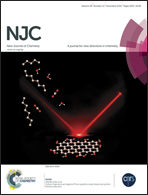Evidence of oriented attachment in the growth of functionalized ZnTe nanoparticles for potential applications in bio-imaging†
Abstract
This study reports a solution based, low temperature route towards the synthesis of water soluble cysteine capped zinc telluride (ZnTe) nanoparticles under the influence of variations in pH and reaction time. The optical properties of the ZnTe nanoparticles display broad emission peaks ranging between 365–415 nm, which make them useful for imaging and biological labelling applications. Transmission electron microscopy (TEM) and high resolution TEM studies indicated that the particles are uniform in size and shape, however at the 2 hour reaction time interval the nanoparticle growth enters a transition phase where the morphology changes from nanospheres to nanorods. The formation of the ZnTe nanoparticles relative to reaction temperature, pH and time is typical of the oriented attachment growth mechanism. X-ray diffraction patterns confirmed the crystalline cubic phase. The surface charge of the functionalised ZnTe was also determined. The fluorescence properties and optical stability of the ZnTe nanoparticles in DNA plasmid pGEMT Easy were studied using fluorescence (365–395 nm filter) and phase-contrast (UV 2A 330–380 nm filter) microscopy techniques.


 Please wait while we load your content...
Please wait while we load your content...